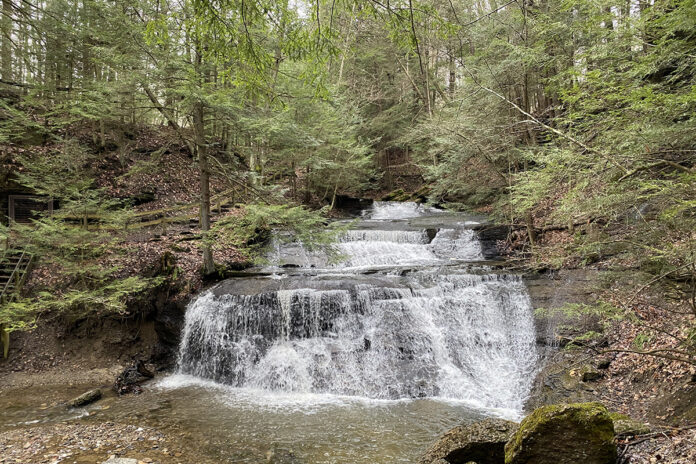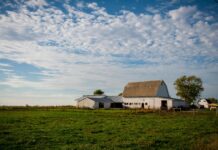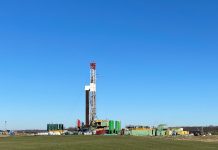
This winter I’ve had more opportunities than most to appreciate the presence of conifers in nearby woodlands. Their deep shades of green have added color to my winter hikes and their presence has kept trails warm and clear of snow. I’ve stopped to admire their size, color and distinct scent many times over the past few months.
I’m certain the local wildlife values these abundant giants even more than I could ever imagine because they provide food and shelter throughout the winter, and host even more in the spring and summer.
I didn’t know much about identifying different types of conifers or distinguishing pine trees from spruce, fir, hemlock, yew or cypress trees until I took an interest in the conservation benefits and foraging value of individual species. I just called any conifer I encountered a pine tree. I was wrong. Each type of conifer has unique traits and benefits for its environment.
Yew
Yews are trees and shrubs that mostly grow in northern temperate regions. They are slightly aromatic and resinous. They do not have flowers or fruit. There are about 20 species in the world. North America is home to four native tree species and one shrub species.
Needles. Their evergreen leaves or needles are flattened and stiff with short leafstalks. They extend down either side of the twigs they’re attached to, alternating and spreading in two rows.
Tree size and structure. The yew family includes both trees and shrubs. Yew shrubs grow stout with spreading branches. Yew trees are on the smaller side, growing to maturity at about 23-30 feet tall. The shape of yew trees can vary from conical to columnar to a loose form with rows of horizontal, spreading branches.
Bark. Yews typically have thin brownish or greyish bark that peels off in patches. Bark can range in texture from scaly to smooth.
Cones. Unlike other conifers, the male and female cones appear on separate trees. They usually grow solitary from scaly buds at the leaf base. Male cones are rounded with several pollen sacs on a stalk. Female cones are very distinct and almost resemble the appearance of red berries. A single seed is produced inside the fleshy female cones after they’re pollinated by the male cones. Seeds are naked, elliptical and nutlike.
Conservation benefits. Yews provide year-round cover to wildlife.
Foraging value. Yews are poisonous to people, domestic animals and wildlife.
Pine
Pines are large trees without flowers or fruit that grow in northern temperate forests and tropical mountain regions. They are resinous, mostly evergreen and have soft lightweight wood. The pine family includes larches, spruces, hemlocks and firs. Collectively, there are about 200 species of trees in the pine family worldwide and 61 native species in North America.
Although a variety of genera are included in the pine family, there are subtle differences between the pine tree genus and the other genera within the family.
Needles. Pine trees have very distinct needles. They are long, soft and flexible and they grow in clusters of two, three or five. The characteristic of having needles that grow in bundles is unique to pine trees.
Tree size and structure. Pine trees vary in size from one species to the next. They can reach maturity from heights of 10 feet up to hundreds of feet. Pines are typically thought of as having a very conical shape, however, not all pines do. Pines can be flat or rounded on top. They can be loosely or densely packed with branches.
Bark. Pine tree bark can also vary. But typically, young pines have smooth bark that develops a flakey, reddish-brown color with age.
Cones. Unlike yews, all members of the pine family (pines, larches, spruces, hemlocks and firs) have both male and female cones on the same tree. Male cones are small and herbaceous and female cones are large and woody with many scales that open to disperse seeds. Pine cones are more rigid than their relatives’ cones, featuring thick woody scales. Additionally, their scales typically have spines or prickles. When they reach maturity, they hang down to disperse seeds and then fall to the ground.
Conservation benefits. Pines provide year-round food and shelter for wildlife. They are also host trees for a variety of insects.
Foraging value. Pine needles, bark and resin can be collected and used to make teas, salves, oils and tinctures with a number of nutritional and medicinal benefits. Find more information here.
Spruce
Spruce trees are another member of the pine family. They are large trees that typically have a straight trunk and a pyramid-shaped crown of spreading branches. Many species of spruce trees grow in pure stands.
Needles. Unlike pine needles, spruce needles attach individually to branches and twigs via a short wooden structure called a pulvinus. They only shed their needles once every 10 years. When needles are shed, the pulvini remain attached, leaving the branches rough. Spruce needles have a distinct square shape and they tend to be stiff and sharply pointed.
Tree size and structure. Spruce trees typically reach 60-200 feet tall at maturity. They can be distinguished by their straight trunks, whorled branches and conical form.
Bark. Spruce trees generally have rough bark that becomes furrowed and scaly with age.
Cones. Spruce tree cones are similar to pine tree cones. However, instead of thick, woody scales, spruce cone scales are thinner and more papery in texture. Like pine cones, they hang down when they reach maturity and drop to the ground intact.
Conservation benefits. Spruce trees provide food and shelter for wildlife year-round.
Foraging value. Tea can be made with spruce tree needles and the tips of spruce tips can be used in salads and cooked dishes. Spruce tree resin can be used to make oils and salves to treat skin conditions.
Fir
Fir trees are another member of the pine family. They are large trees, but typically smaller than the largest pines and spruces. They can most frequently be found in coniferous forests, growing in pure stands or among spruce trees.
Needles. Like spruce needles, fir needles are also attached individually to branches. However, they are directly attached rather than being attached via pulvini. This also means their branches remain smooth when needles are shed. Fir needles are soft and flat.
Tree size and structure. Fir trees typically reach maturity between 40 and 60 feet tall. They are known for their dense branches and conical shape, which is why they are frequently produced commercially for Christmas trees.
Bark. Fir trees have smooth grey bark when they are young that develops a furrowed appearance as they age.
Cones. Unlike pine cones and spruce cones, fir cones start developing upward and remain upward until they reach maturity. Then the scales and seeds of fir cones break loose and crumble away from the central stalk, while the cone is still attached to the tree. Fir cones seldom reach the ground intact.
Conservation benefits. Fir trees provide food and shelter for a variety of wildlife year-round.
Foraging value. Fir tree needles can be used to make tea and the resin can be used to make oils and salves to treat skin conditions.
Hemlock

Hemlocks are another member of the pine tree family. They are large trees that typically grow in mixed forests and pure stands.
Needles. Their needles are flat, flexible and rounded at the tip. They grow in two rows from very short leafstalks. They are a deep shiny green.
Tree size and structure. Hemlocks typically grow to 60-70 feet tall. They grow into slender conical shapes and looser, branchier round shapes, depending on their environment.
Bark. Hemlock bark is thick with a reddish-brown coloration.
Cones. Their cones are much smaller than other members of the pine family. They resemble small pine cones, generously dispersed on the slender Hemlock tree branches. They point down when mature and fall to the ground after they’ve released their seeds. Their scales are thinner and more papery than pine cone scales, making them similar to spruce cones in that way.
Conservation benefits. Hemlock trees provide food and habitat for more than 120 species of wildlife year-round.
Foraging value. Hemlock twigs and needles can be used to make tea.
Cypress
The cypress family is made up of evergreen trees and shrubs that don’t bear flowers or fruits. They grow in a range of habitats from swamps to mountains in both pure stands and mixed forests. There are about 130 species worldwide and 26 native tree species and 1 native shrub species in North America.
Leaves. Cypress leaves are different from other evergreens. They usually take one of two forms, either appearing small and scalelike or awl-shaped and producing flattened and angled twigs.
Tree size and structure. Members of the cypress family can take the form of both trees and shrubs in a range of sizes. They frequently grow in the conical shape that’s common to so many conifers, but they can also grow into rounded bushy shapes.
Bark. Cypress trees and shrubs typically have a grey fibrous bark that becomes more scaly as they age.
Cones. Male and female cones are typically present on the same tree or shrub. Male cones are small and herbaceous and female cones are woody and composed of a few cone scales, except in the case of junipers when they appear berrylike.
Conservation benefits. Cypress trees and bushes provide shelter for wildlife and host sites for butterflies and moths. Additionally, juniper berries are consumed by a number of birds and other wildlife.
Foraging value. Cypress trees and bushes can be hard to distinguish from one species to the next and can be toxic to humans.
Related Content
- How to brew pine needle tea
- How to grow your own Christmas tree
- How to find a native Christmas tree to plant in your backyard










This article would be greatly enhanced if there were representative pictures to go along with the descriptions. Interesting article, nonetheless.